IKEA's Strategic Management and Internationalization in India
VerifiedAdded on 2023/05/29
|12
|3590
|399
Essay
AI Summary
This essay provides a critical evaluation of IKEA's strategy in India, examining the factors that influenced its market entry and subsequent operations. It delves into the motivations behind IKEA's internationalization, highlighting the benefits of entering the Indian market, such as its large consumer base and availability of resources. The essay discusses the challenges IKEA faced regarding FDI policies and local sourcing requirements, along with the strategies adopted to overcome these obstacles. It analyzes IKEA's competitive advantages, including operational effectiveness, positioning, and resource-based approaches, and the firm's use of lean production and business excellence to minimize waste and improve operations. Furthermore, the essay explores the OLI framework, emphasizing the importance of ownership, location, and internalization in IKEA's success in India. Finally, the essay considers the political, economic, social, technological, legal, and environmental factors impacting IKEA's business in India through a PESTLE analysis, offering a comprehensive overview of IKEA's strategic management and internationalization efforts in the Indian market.
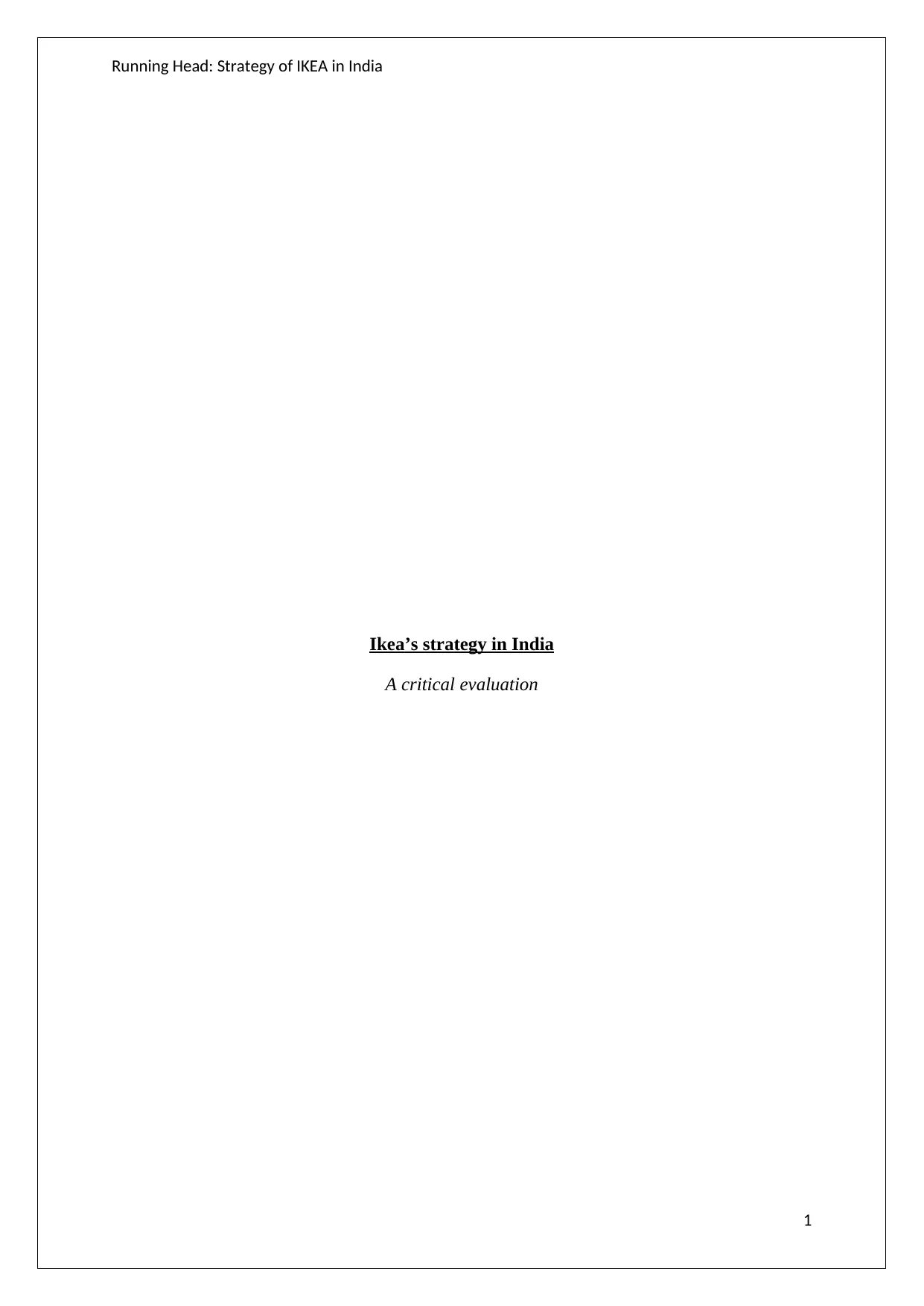
Running Head: Strategy of IKEA in India
Ikea’s strategy in India
A critical evaluation
1
Ikea’s strategy in India
A critical evaluation
1
Paraphrase This Document
Need a fresh take? Get an instant paraphrase of this document with our AI Paraphraser
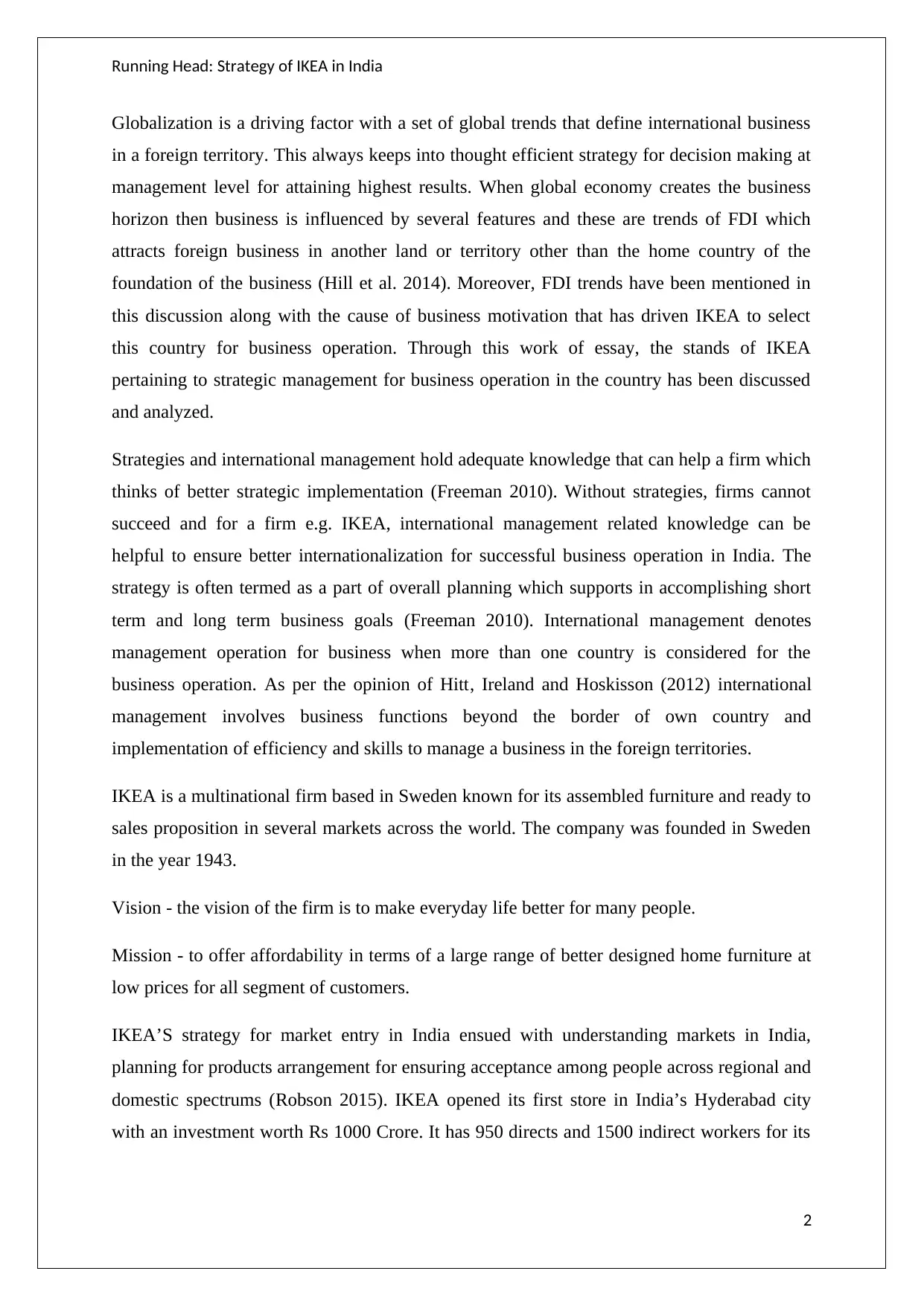
Running Head: Strategy of IKEA in India
Globalization is a driving factor with a set of global trends that define international business
in a foreign territory. This always keeps into thought efficient strategy for decision making at
management level for attaining highest results. When global economy creates the business
horizon then business is influenced by several features and these are trends of FDI which
attracts foreign business in another land or territory other than the home country of the
foundation of the business (Hill et al. 2014). Moreover, FDI trends have been mentioned in
this discussion along with the cause of business motivation that has driven IKEA to select
this country for business operation. Through this work of essay, the stands of IKEA
pertaining to strategic management for business operation in the country has been discussed
and analyzed.
Strategies and international management hold adequate knowledge that can help a firm which
thinks of better strategic implementation (Freeman 2010). Without strategies, firms cannot
succeed and for a firm e.g. IKEA, international management related knowledge can be
helpful to ensure better internationalization for successful business operation in India. The
strategy is often termed as a part of overall planning which supports in accomplishing short
term and long term business goals (Freeman 2010). International management denotes
management operation for business when more than one country is considered for the
business operation. As per the opinion of Hitt, Ireland and Hoskisson (2012) international
management involves business functions beyond the border of own country and
implementation of efficiency and skills to manage a business in the foreign territories.
IKEA is a multinational firm based in Sweden known for its assembled furniture and ready to
sales proposition in several markets across the world. The company was founded in Sweden
in the year 1943.
Vision - the vision of the firm is to make everyday life better for many people.
Mission - to offer affordability in terms of a large range of better designed home furniture at
low prices for all segment of customers.
IKEA’S strategy for market entry in India ensued with understanding markets in India,
planning for products arrangement for ensuring acceptance among people across regional and
domestic spectrums (Robson 2015). IKEA opened its first store in India’s Hyderabad city
with an investment worth Rs 1000 Crore. It has 950 directs and 1500 indirect workers for its
2
Globalization is a driving factor with a set of global trends that define international business
in a foreign territory. This always keeps into thought efficient strategy for decision making at
management level for attaining highest results. When global economy creates the business
horizon then business is influenced by several features and these are trends of FDI which
attracts foreign business in another land or territory other than the home country of the
foundation of the business (Hill et al. 2014). Moreover, FDI trends have been mentioned in
this discussion along with the cause of business motivation that has driven IKEA to select
this country for business operation. Through this work of essay, the stands of IKEA
pertaining to strategic management for business operation in the country has been discussed
and analyzed.
Strategies and international management hold adequate knowledge that can help a firm which
thinks of better strategic implementation (Freeman 2010). Without strategies, firms cannot
succeed and for a firm e.g. IKEA, international management related knowledge can be
helpful to ensure better internationalization for successful business operation in India. The
strategy is often termed as a part of overall planning which supports in accomplishing short
term and long term business goals (Freeman 2010). International management denotes
management operation for business when more than one country is considered for the
business operation. As per the opinion of Hitt, Ireland and Hoskisson (2012) international
management involves business functions beyond the border of own country and
implementation of efficiency and skills to manage a business in the foreign territories.
IKEA is a multinational firm based in Sweden known for its assembled furniture and ready to
sales proposition in several markets across the world. The company was founded in Sweden
in the year 1943.
Vision - the vision of the firm is to make everyday life better for many people.
Mission - to offer affordability in terms of a large range of better designed home furniture at
low prices for all segment of customers.
IKEA’S strategy for market entry in India ensued with understanding markets in India,
planning for products arrangement for ensuring acceptance among people across regional and
domestic spectrums (Robson 2015). IKEA opened its first store in India’s Hyderabad city
with an investment worth Rs 1000 Crore. It has 950 directs and 1500 indirect workers for its
2
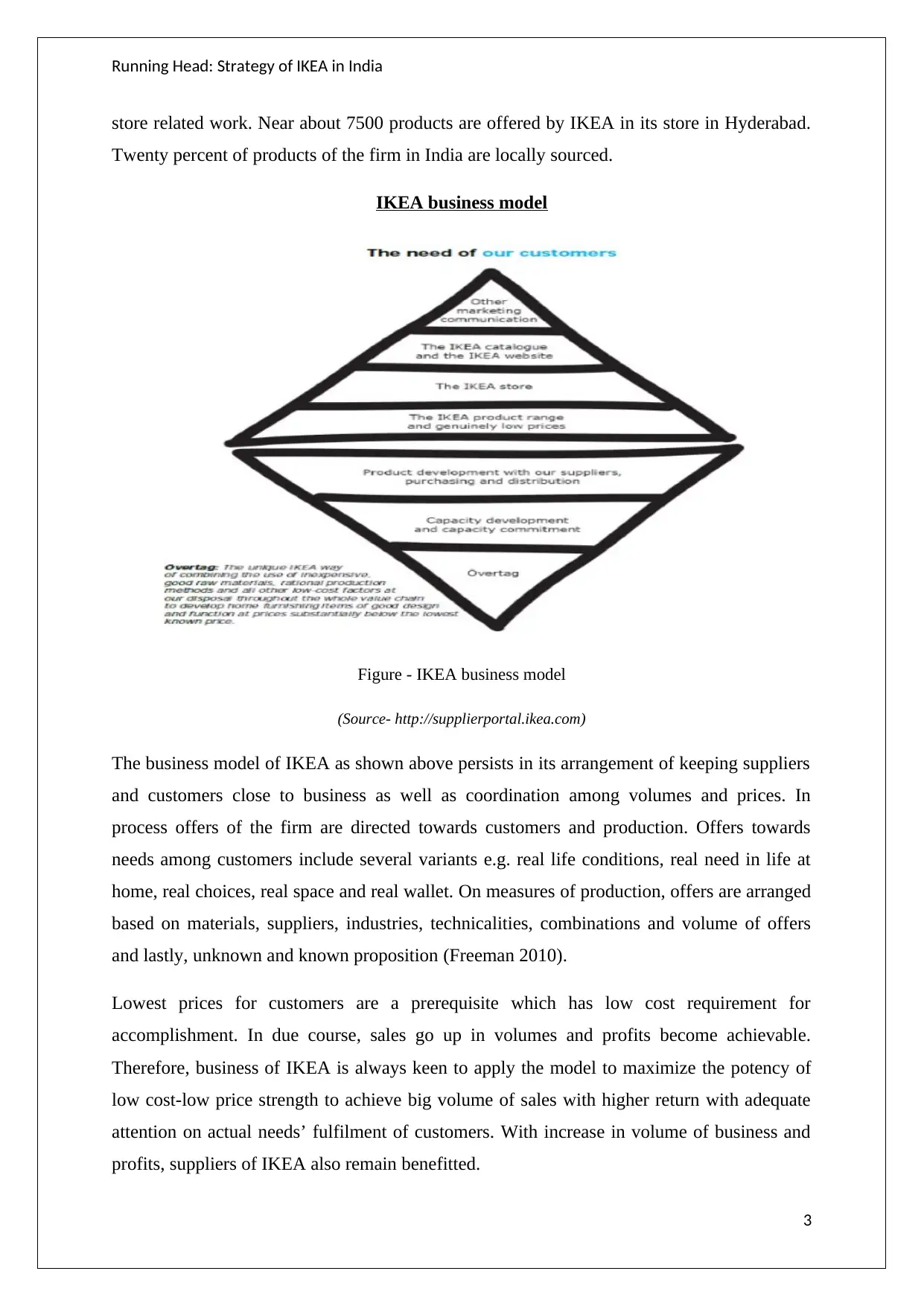
Running Head: Strategy of IKEA in India
store related work. Near about 7500 products are offered by IKEA in its store in Hyderabad.
Twenty percent of products of the firm in India are locally sourced.
IKEA business model
Figure - IKEA business model
(Source- http://supplierportal.ikea.com)
The business model of IKEA as shown above persists in its arrangement of keeping suppliers
and customers close to business as well as coordination among volumes and prices. In
process offers of the firm are directed towards customers and production. Offers towards
needs among customers include several variants e.g. real life conditions, real need in life at
home, real choices, real space and real wallet. On measures of production, offers are arranged
based on materials, suppliers, industries, technicalities, combinations and volume of offers
and lastly, unknown and known proposition (Freeman 2010).
Lowest prices for customers are a prerequisite which has low cost requirement for
accomplishment. In due course, sales go up in volumes and profits become achievable.
Therefore, business of IKEA is always keen to apply the model to maximize the potency of
low cost-low price strength to achieve big volume of sales with higher return with adequate
attention on actual needs’ fulfilment of customers. With increase in volume of business and
profits, suppliers of IKEA also remain benefitted.
3
store related work. Near about 7500 products are offered by IKEA in its store in Hyderabad.
Twenty percent of products of the firm in India are locally sourced.
IKEA business model
Figure - IKEA business model
(Source- http://supplierportal.ikea.com)
The business model of IKEA as shown above persists in its arrangement of keeping suppliers
and customers close to business as well as coordination among volumes and prices. In
process offers of the firm are directed towards customers and production. Offers towards
needs among customers include several variants e.g. real life conditions, real need in life at
home, real choices, real space and real wallet. On measures of production, offers are arranged
based on materials, suppliers, industries, technicalities, combinations and volume of offers
and lastly, unknown and known proposition (Freeman 2010).
Lowest prices for customers are a prerequisite which has low cost requirement for
accomplishment. In due course, sales go up in volumes and profits become achievable.
Therefore, business of IKEA is always keen to apply the model to maximize the potency of
low cost-low price strength to achieve big volume of sales with higher return with adequate
attention on actual needs’ fulfilment of customers. With increase in volume of business and
profits, suppliers of IKEA also remain benefitted.
3
⊘ This is a preview!⊘
Do you want full access?
Subscribe today to unlock all pages.

Trusted by 1+ million students worldwide
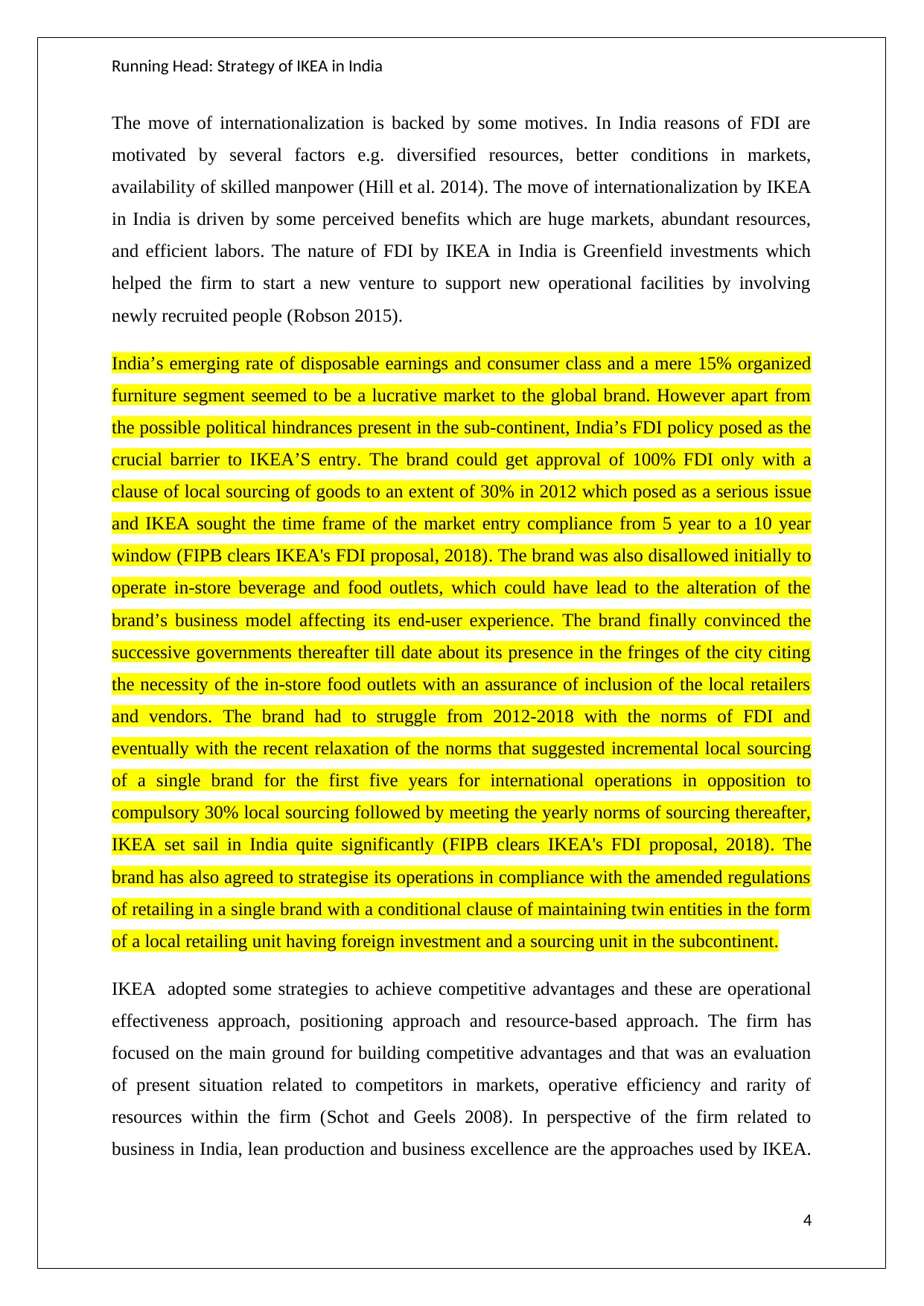
Running Head: Strategy of IKEA in India
The move of internationalization is backed by some motives. In India reasons of FDI are
motivated by several factors e.g. diversified resources, better conditions in markets,
availability of skilled manpower (Hill et al. 2014). The move of internationalization by IKEA
in India is driven by some perceived benefits which are huge markets, abundant resources,
and efficient labors. The nature of FDI by IKEA in India is Greenfield investments which
helped the firm to start a new venture to support new operational facilities by involving
newly recruited people (Robson 2015).
India’s emerging rate of disposable earnings and consumer class and a mere 15% organized
furniture segment seemed to be a lucrative market to the global brand. However apart from
the possible political hindrances present in the sub-continent, India’s FDI policy posed as the
crucial barrier to IKEA’S entry. The brand could get approval of 100% FDI only with a
clause of local sourcing of goods to an extent of 30% in 2012 which posed as a serious issue
and IKEA sought the time frame of the market entry compliance from 5 year to a 10 year
window (FIPB clears IKEA's FDI proposal, 2018). The brand was also disallowed initially to
operate in-store beverage and food outlets, which could have lead to the alteration of the
brand’s business model affecting its end-user experience. The brand finally convinced the
successive governments thereafter till date about its presence in the fringes of the city citing
the necessity of the in-store food outlets with an assurance of inclusion of the local retailers
and vendors. The brand had to struggle from 2012-2018 with the norms of FDI and
eventually with the recent relaxation of the norms that suggested incremental local sourcing
of a single brand for the first five years for international operations in opposition to
compulsory 30% local sourcing followed by meeting the yearly norms of sourcing thereafter,
IKEA set sail in India quite significantly (FIPB clears IKEA's FDI proposal, 2018). The
brand has also agreed to strategise its operations in compliance with the amended regulations
of retailing in a single brand with a conditional clause of maintaining twin entities in the form
of a local retailing unit having foreign investment and a sourcing unit in the subcontinent.
IKEA adopted some strategies to achieve competitive advantages and these are operational
effectiveness approach, positioning approach and resource-based approach. The firm has
focused on the main ground for building competitive advantages and that was an evaluation
of present situation related to competitors in markets, operative efficiency and rarity of
resources within the firm (Schot and Geels 2008). In perspective of the firm related to
business in India, lean production and business excellence are the approaches used by IKEA.
4
The move of internationalization is backed by some motives. In India reasons of FDI are
motivated by several factors e.g. diversified resources, better conditions in markets,
availability of skilled manpower (Hill et al. 2014). The move of internationalization by IKEA
in India is driven by some perceived benefits which are huge markets, abundant resources,
and efficient labors. The nature of FDI by IKEA in India is Greenfield investments which
helped the firm to start a new venture to support new operational facilities by involving
newly recruited people (Robson 2015).
India’s emerging rate of disposable earnings and consumer class and a mere 15% organized
furniture segment seemed to be a lucrative market to the global brand. However apart from
the possible political hindrances present in the sub-continent, India’s FDI policy posed as the
crucial barrier to IKEA’S entry. The brand could get approval of 100% FDI only with a
clause of local sourcing of goods to an extent of 30% in 2012 which posed as a serious issue
and IKEA sought the time frame of the market entry compliance from 5 year to a 10 year
window (FIPB clears IKEA's FDI proposal, 2018). The brand was also disallowed initially to
operate in-store beverage and food outlets, which could have lead to the alteration of the
brand’s business model affecting its end-user experience. The brand finally convinced the
successive governments thereafter till date about its presence in the fringes of the city citing
the necessity of the in-store food outlets with an assurance of inclusion of the local retailers
and vendors. The brand had to struggle from 2012-2018 with the norms of FDI and
eventually with the recent relaxation of the norms that suggested incremental local sourcing
of a single brand for the first five years for international operations in opposition to
compulsory 30% local sourcing followed by meeting the yearly norms of sourcing thereafter,
IKEA set sail in India quite significantly (FIPB clears IKEA's FDI proposal, 2018). The
brand has also agreed to strategise its operations in compliance with the amended regulations
of retailing in a single brand with a conditional clause of maintaining twin entities in the form
of a local retailing unit having foreign investment and a sourcing unit in the subcontinent.
IKEA adopted some strategies to achieve competitive advantages and these are operational
effectiveness approach, positioning approach and resource-based approach. The firm has
focused on the main ground for building competitive advantages and that was an evaluation
of present situation related to competitors in markets, operative efficiency and rarity of
resources within the firm (Schot and Geels 2008). In perspective of the firm related to
business in India, lean production and business excellence are the approaches used by IKEA.
4
Paraphrase This Document
Need a fresh take? Get an instant paraphrase of this document with our AI Paraphraser
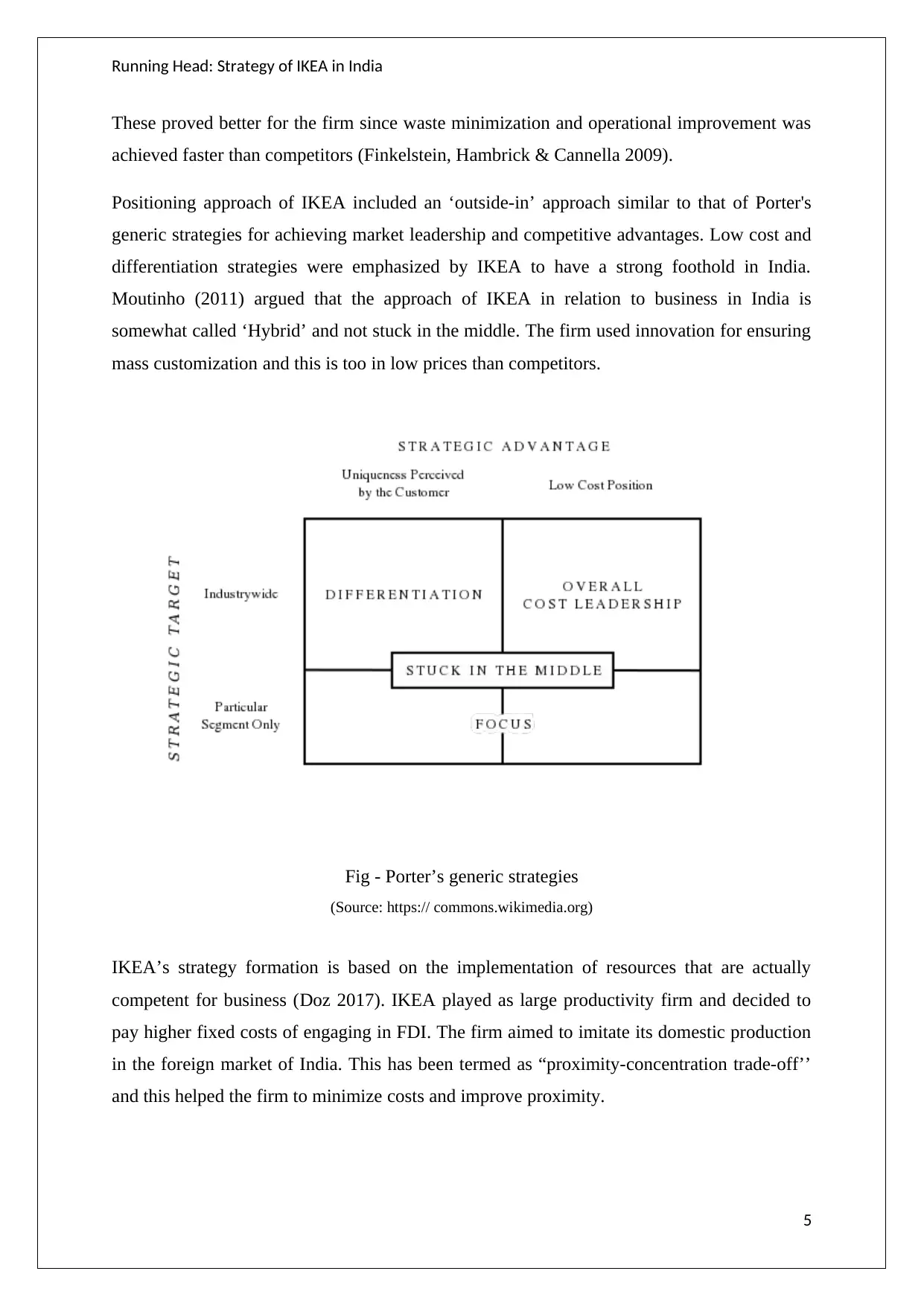
Running Head: Strategy of IKEA in India
These proved better for the firm since waste minimization and operational improvement was
achieved faster than competitors (Finkelstein, Hambrick & Cannella 2009).
Positioning approach of IKEA included an ‘outside-in’ approach similar to that of Porter's
generic strategies for achieving market leadership and competitive advantages. Low cost and
differentiation strategies were emphasized by IKEA to have a strong foothold in India.
Moutinho (2011) argued that the approach of IKEA in relation to business in India is
somewhat called ‘Hybrid’ and not stuck in the middle. The firm used innovation for ensuring
mass customization and this is too in low prices than competitors.
Fig - Porter’s generic strategies
(Source: https:// commons.wikimedia.org)
IKEA’s strategy formation is based on the implementation of resources that are actually
competent for business (Doz 2017). IKEA played as large productivity firm and decided to
pay higher fixed costs of engaging in FDI. The firm aimed to imitate its domestic production
in the foreign market of India. This has been termed as “proximity-concentration trade-off’’
and this helped the firm to minimize costs and improve proximity.
5
These proved better for the firm since waste minimization and operational improvement was
achieved faster than competitors (Finkelstein, Hambrick & Cannella 2009).
Positioning approach of IKEA included an ‘outside-in’ approach similar to that of Porter's
generic strategies for achieving market leadership and competitive advantages. Low cost and
differentiation strategies were emphasized by IKEA to have a strong foothold in India.
Moutinho (2011) argued that the approach of IKEA in relation to business in India is
somewhat called ‘Hybrid’ and not stuck in the middle. The firm used innovation for ensuring
mass customization and this is too in low prices than competitors.
Fig - Porter’s generic strategies
(Source: https:// commons.wikimedia.org)
IKEA’s strategy formation is based on the implementation of resources that are actually
competent for business (Doz 2017). IKEA played as large productivity firm and decided to
pay higher fixed costs of engaging in FDI. The firm aimed to imitate its domestic production
in the foreign market of India. This has been termed as “proximity-concentration trade-off’’
and this helped the firm to minimize costs and improve proximity.
5
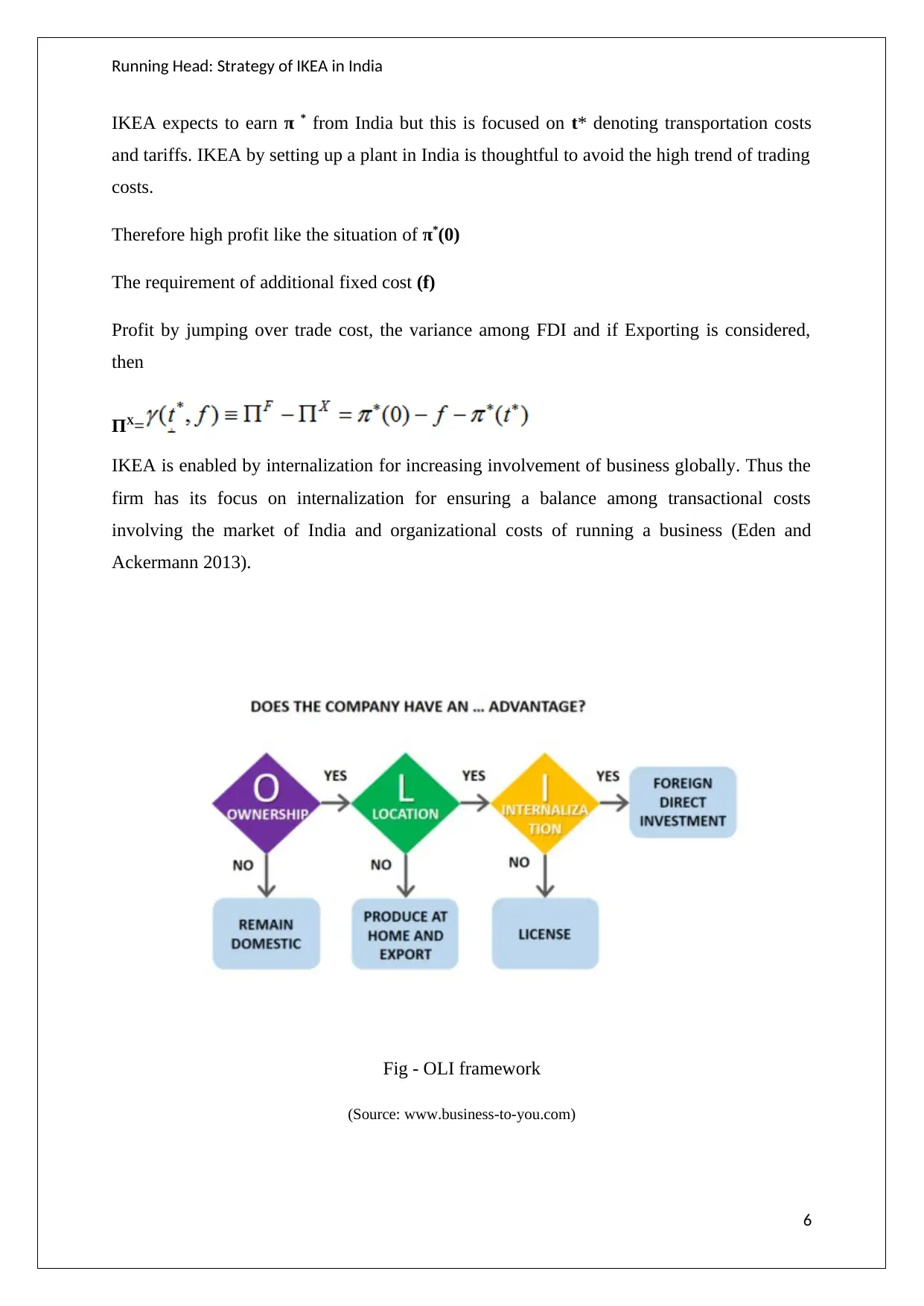
Running Head: Strategy of IKEA in India
IKEA expects to earn π * from India but this is focused on t* denoting transportation costs
and tariffs. IKEA by setting up a plant in India is thoughtful to avoid the high trend of trading
costs.
Therefore high profit like the situation of π*(0)
The requirement of additional fixed cost (f)
Profit by jumping over trade cost, the variance among FDI and if Exporting is considered,
then
ΠX=
IKEA is enabled by internalization for increasing involvement of business globally. Thus the
firm has its focus on internalization for ensuring a balance among transactional costs
involving the market of India and organizational costs of running a business (Eden and
Ackermann 2013).
Fig - OLI framework
(Source: www.business-to-you.com)
6
IKEA expects to earn π * from India but this is focused on t* denoting transportation costs
and tariffs. IKEA by setting up a plant in India is thoughtful to avoid the high trend of trading
costs.
Therefore high profit like the situation of π*(0)
The requirement of additional fixed cost (f)
Profit by jumping over trade cost, the variance among FDI and if Exporting is considered,
then
ΠX=
IKEA is enabled by internalization for increasing involvement of business globally. Thus the
firm has its focus on internalization for ensuring a balance among transactional costs
involving the market of India and organizational costs of running a business (Eden and
Ackermann 2013).
Fig - OLI framework
(Source: www.business-to-you.com)
6
⊘ This is a preview!⊘
Do you want full access?
Subscribe today to unlock all pages.

Trusted by 1+ million students worldwide
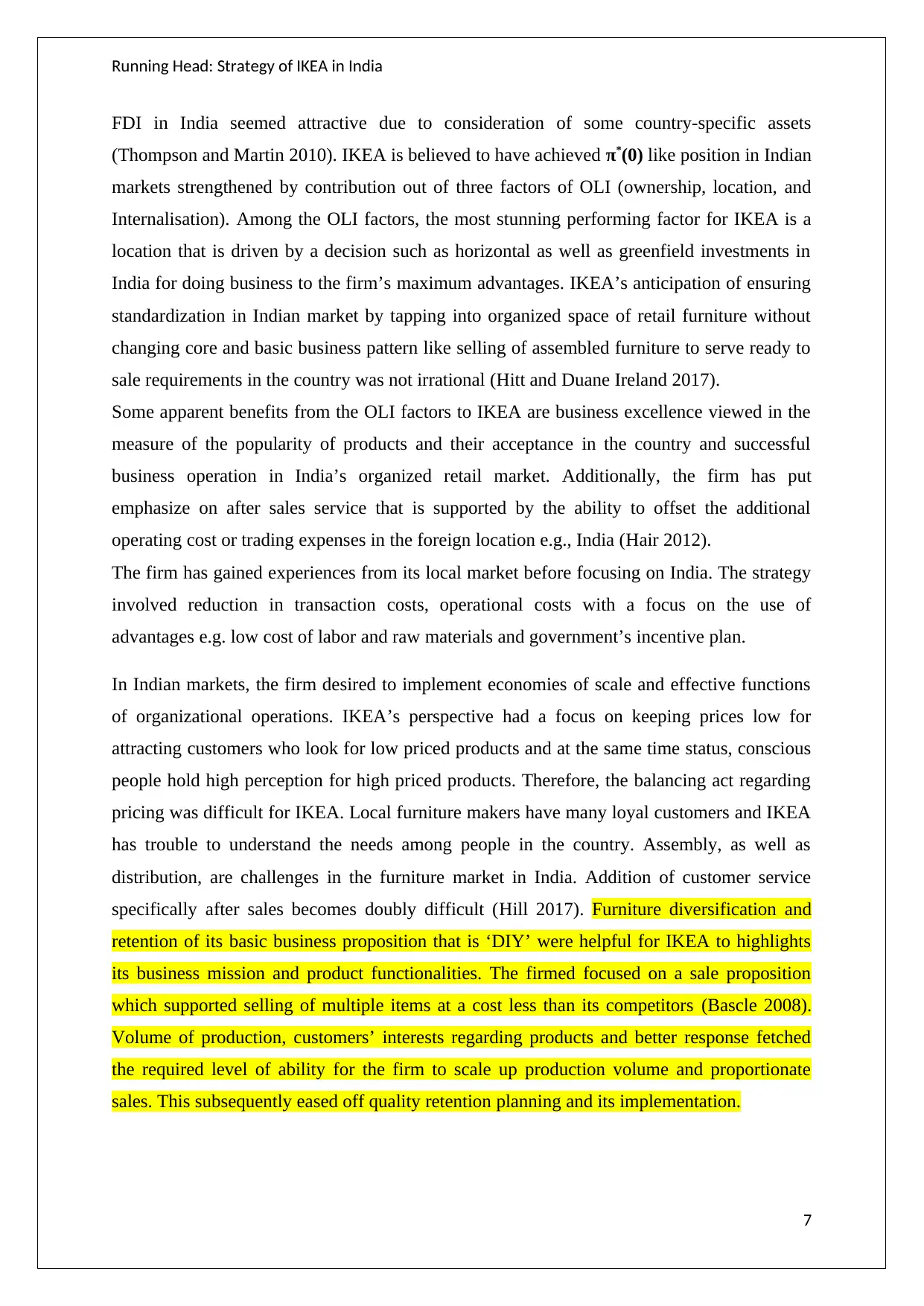
Running Head: Strategy of IKEA in India
FDI in India seemed attractive due to consideration of some country-specific assets
(Thompson and Martin 2010). IKEA is believed to have achieved π*(0) like position in Indian
markets strengthened by contribution out of three factors of OLI (ownership, location, and
Internalisation). Among the OLI factors, the most stunning performing factor for IKEA is a
location that is driven by a decision such as horizontal as well as greenfield investments in
India for doing business to the firm’s maximum advantages. IKEA’s anticipation of ensuring
standardization in Indian market by tapping into organized space of retail furniture without
changing core and basic business pattern like selling of assembled furniture to serve ready to
sale requirements in the country was not irrational (Hitt and Duane Ireland 2017).
Some apparent benefits from the OLI factors to IKEA are business excellence viewed in the
measure of the popularity of products and their acceptance in the country and successful
business operation in India’s organized retail market. Additionally, the firm has put
emphasize on after sales service that is supported by the ability to offset the additional
operating cost or trading expenses in the foreign location e.g., India (Hair 2012).
The firm has gained experiences from its local market before focusing on India. The strategy
involved reduction in transaction costs, operational costs with a focus on the use of
advantages e.g. low cost of labor and raw materials and government’s incentive plan.
In Indian markets, the firm desired to implement economies of scale and effective functions
of organizational operations. IKEA’s perspective had a focus on keeping prices low for
attracting customers who look for low priced products and at the same time status, conscious
people hold high perception for high priced products. Therefore, the balancing act regarding
pricing was difficult for IKEA. Local furniture makers have many loyal customers and IKEA
has trouble to understand the needs among people in the country. Assembly, as well as
distribution, are challenges in the furniture market in India. Addition of customer service
specifically after sales becomes doubly difficult (Hill 2017). Furniture diversification and
retention of its basic business proposition that is ‘DIY’ were helpful for IKEA to highlights
its business mission and product functionalities. The firmed focused on a sale proposition
which supported selling of multiple items at a cost less than its competitors (Bascle 2008).
Volume of production, customers’ interests regarding products and better response fetched
the required level of ability for the firm to scale up production volume and proportionate
sales. This subsequently eased off quality retention planning and its implementation.
7
FDI in India seemed attractive due to consideration of some country-specific assets
(Thompson and Martin 2010). IKEA is believed to have achieved π*(0) like position in Indian
markets strengthened by contribution out of three factors of OLI (ownership, location, and
Internalisation). Among the OLI factors, the most stunning performing factor for IKEA is a
location that is driven by a decision such as horizontal as well as greenfield investments in
India for doing business to the firm’s maximum advantages. IKEA’s anticipation of ensuring
standardization in Indian market by tapping into organized space of retail furniture without
changing core and basic business pattern like selling of assembled furniture to serve ready to
sale requirements in the country was not irrational (Hitt and Duane Ireland 2017).
Some apparent benefits from the OLI factors to IKEA are business excellence viewed in the
measure of the popularity of products and their acceptance in the country and successful
business operation in India’s organized retail market. Additionally, the firm has put
emphasize on after sales service that is supported by the ability to offset the additional
operating cost or trading expenses in the foreign location e.g., India (Hair 2012).
The firm has gained experiences from its local market before focusing on India. The strategy
involved reduction in transaction costs, operational costs with a focus on the use of
advantages e.g. low cost of labor and raw materials and government’s incentive plan.
In Indian markets, the firm desired to implement economies of scale and effective functions
of organizational operations. IKEA’s perspective had a focus on keeping prices low for
attracting customers who look for low priced products and at the same time status, conscious
people hold high perception for high priced products. Therefore, the balancing act regarding
pricing was difficult for IKEA. Local furniture makers have many loyal customers and IKEA
has trouble to understand the needs among people in the country. Assembly, as well as
distribution, are challenges in the furniture market in India. Addition of customer service
specifically after sales becomes doubly difficult (Hill 2017). Furniture diversification and
retention of its basic business proposition that is ‘DIY’ were helpful for IKEA to highlights
its business mission and product functionalities. The firmed focused on a sale proposition
which supported selling of multiple items at a cost less than its competitors (Bascle 2008).
Volume of production, customers’ interests regarding products and better response fetched
the required level of ability for the firm to scale up production volume and proportionate
sales. This subsequently eased off quality retention planning and its implementation.
7
Paraphrase This Document
Need a fresh take? Get an instant paraphrase of this document with our AI Paraphraser
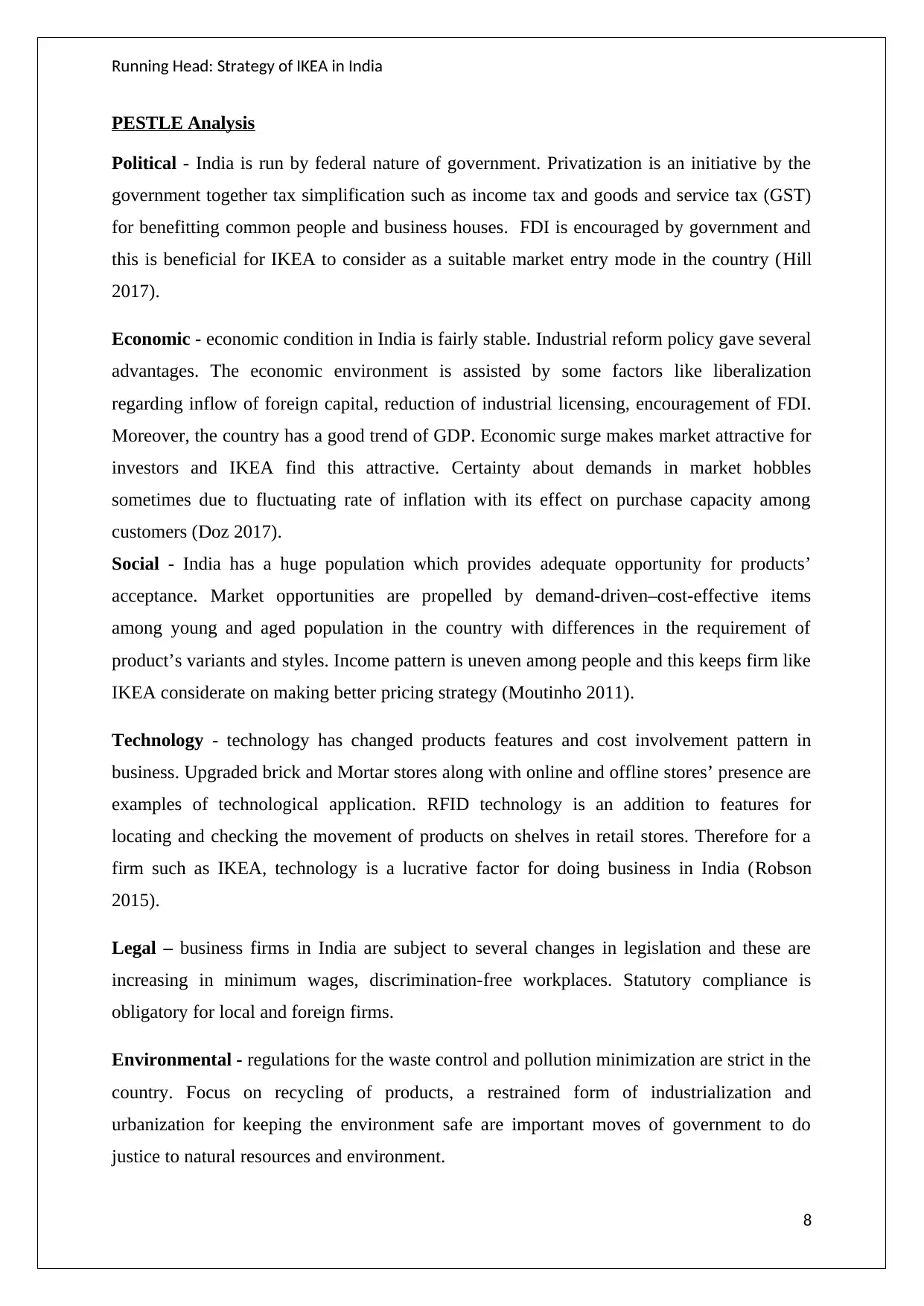
Running Head: Strategy of IKEA in India
PESTLE Analysis
Political - India is run by federal nature of government. Privatization is an initiative by the
government together tax simplification such as income tax and goods and service tax (GST)
for benefitting common people and business houses. FDI is encouraged by government and
this is beneficial for IKEA to consider as a suitable market entry mode in the country (Hill
2017).
Economic - economic condition in India is fairly stable. Industrial reform policy gave several
advantages. The economic environment is assisted by some factors like liberalization
regarding inflow of foreign capital, reduction of industrial licensing, encouragement of FDI.
Moreover, the country has a good trend of GDP. Economic surge makes market attractive for
investors and IKEA find this attractive. Certainty about demands in market hobbles
sometimes due to fluctuating rate of inflation with its effect on purchase capacity among
customers (Doz 2017).
Social - India has a huge population which provides adequate opportunity for products’
acceptance. Market opportunities are propelled by demand-driven–cost-effective items
among young and aged population in the country with differences in the requirement of
product’s variants and styles. Income pattern is uneven among people and this keeps firm like
IKEA considerate on making better pricing strategy (Moutinho 2011).
Technology - technology has changed products features and cost involvement pattern in
business. Upgraded brick and Mortar stores along with online and offline stores’ presence are
examples of technological application. RFID technology is an addition to features for
locating and checking the movement of products on shelves in retail stores. Therefore for a
firm such as IKEA, technology is a lucrative factor for doing business in India (Robson
2015).
Legal – business firms in India are subject to several changes in legislation and these are
increasing in minimum wages, discrimination-free workplaces. Statutory compliance is
obligatory for local and foreign firms.
Environmental - regulations for the waste control and pollution minimization are strict in the
country. Focus on recycling of products, a restrained form of industrialization and
urbanization for keeping the environment safe are important moves of government to do
justice to natural resources and environment.
8
PESTLE Analysis
Political - India is run by federal nature of government. Privatization is an initiative by the
government together tax simplification such as income tax and goods and service tax (GST)
for benefitting common people and business houses. FDI is encouraged by government and
this is beneficial for IKEA to consider as a suitable market entry mode in the country (Hill
2017).
Economic - economic condition in India is fairly stable. Industrial reform policy gave several
advantages. The economic environment is assisted by some factors like liberalization
regarding inflow of foreign capital, reduction of industrial licensing, encouragement of FDI.
Moreover, the country has a good trend of GDP. Economic surge makes market attractive for
investors and IKEA find this attractive. Certainty about demands in market hobbles
sometimes due to fluctuating rate of inflation with its effect on purchase capacity among
customers (Doz 2017).
Social - India has a huge population which provides adequate opportunity for products’
acceptance. Market opportunities are propelled by demand-driven–cost-effective items
among young and aged population in the country with differences in the requirement of
product’s variants and styles. Income pattern is uneven among people and this keeps firm like
IKEA considerate on making better pricing strategy (Moutinho 2011).
Technology - technology has changed products features and cost involvement pattern in
business. Upgraded brick and Mortar stores along with online and offline stores’ presence are
examples of technological application. RFID technology is an addition to features for
locating and checking the movement of products on shelves in retail stores. Therefore for a
firm such as IKEA, technology is a lucrative factor for doing business in India (Robson
2015).
Legal – business firms in India are subject to several changes in legislation and these are
increasing in minimum wages, discrimination-free workplaces. Statutory compliance is
obligatory for local and foreign firms.
Environmental - regulations for the waste control and pollution minimization are strict in the
country. Focus on recycling of products, a restrained form of industrialization and
urbanization for keeping the environment safe are important moves of government to do
justice to natural resources and environment.
8
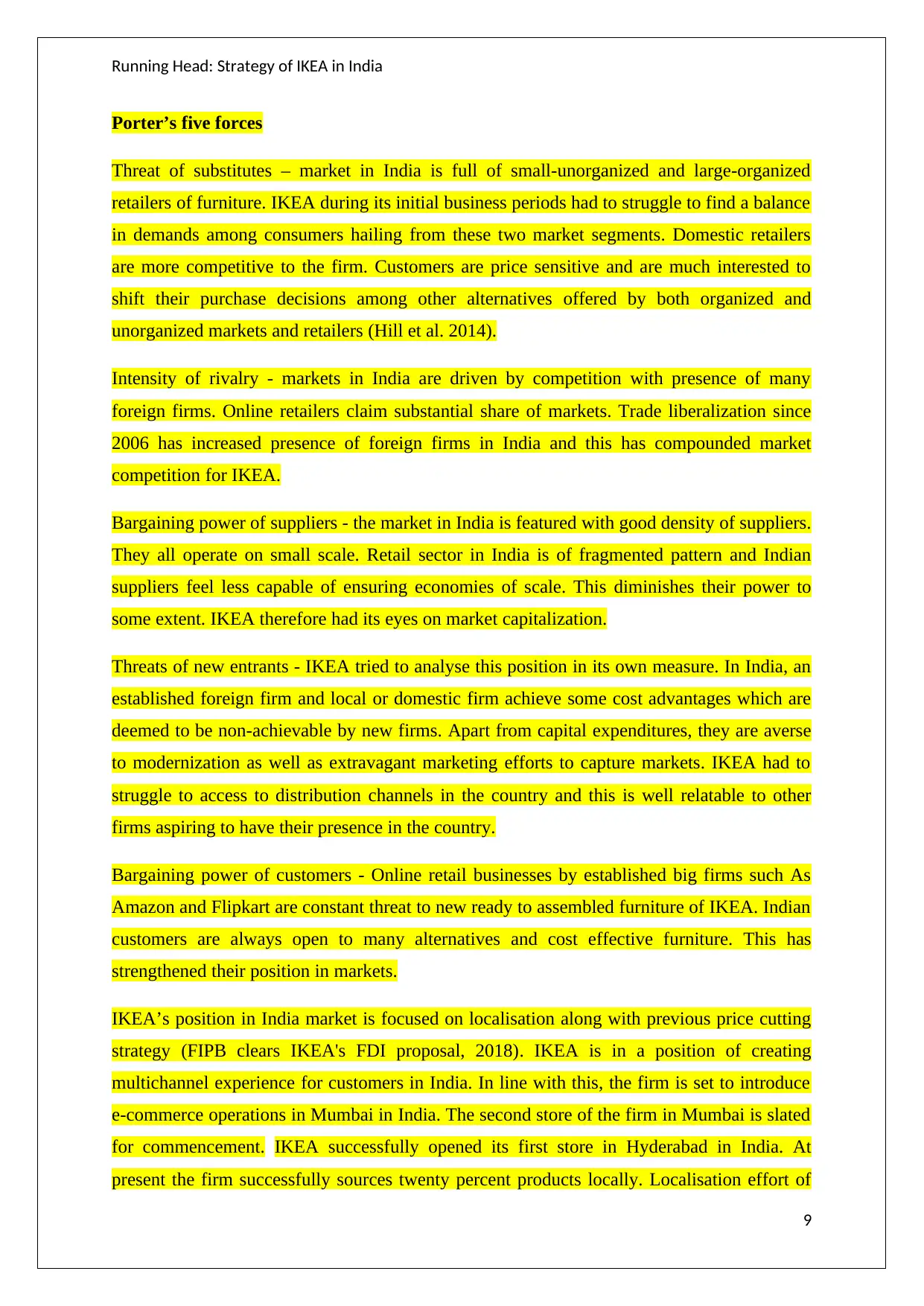
Running Head: Strategy of IKEA in India
Porter’s five forces
Threat of substitutes – market in India is full of small-unorganized and large-organized
retailers of furniture. IKEA during its initial business periods had to struggle to find a balance
in demands among consumers hailing from these two market segments. Domestic retailers
are more competitive to the firm. Customers are price sensitive and are much interested to
shift their purchase decisions among other alternatives offered by both organized and
unorganized markets and retailers (Hill et al. 2014).
Intensity of rivalry - markets in India are driven by competition with presence of many
foreign firms. Online retailers claim substantial share of markets. Trade liberalization since
2006 has increased presence of foreign firms in India and this has compounded market
competition for IKEA.
Bargaining power of suppliers - the market in India is featured with good density of suppliers.
They all operate on small scale. Retail sector in India is of fragmented pattern and Indian
suppliers feel less capable of ensuring economies of scale. This diminishes their power to
some extent. IKEA therefore had its eyes on market capitalization.
Threats of new entrants - IKEA tried to analyse this position in its own measure. In India, an
established foreign firm and local or domestic firm achieve some cost advantages which are
deemed to be non-achievable by new firms. Apart from capital expenditures, they are averse
to modernization as well as extravagant marketing efforts to capture markets. IKEA had to
struggle to access to distribution channels in the country and this is well relatable to other
firms aspiring to have their presence in the country.
Bargaining power of customers - Online retail businesses by established big firms such As
Amazon and Flipkart are constant threat to new ready to assembled furniture of IKEA. Indian
customers are always open to many alternatives and cost effective furniture. This has
strengthened their position in markets.
IKEA’s position in India market is focused on localisation along with previous price cutting
strategy (FIPB clears IKEA's FDI proposal, 2018). IKEA is in a position of creating
multichannel experience for customers in India. In line with this, the firm is set to introduce
e-commerce operations in Mumbai in India. The second store of the firm in Mumbai is slated
for commencement. IKEA successfully opened its first store in Hyderabad in India. At
present the firm successfully sources twenty percent products locally. Localisation effort of
9
Porter’s five forces
Threat of substitutes – market in India is full of small-unorganized and large-organized
retailers of furniture. IKEA during its initial business periods had to struggle to find a balance
in demands among consumers hailing from these two market segments. Domestic retailers
are more competitive to the firm. Customers are price sensitive and are much interested to
shift their purchase decisions among other alternatives offered by both organized and
unorganized markets and retailers (Hill et al. 2014).
Intensity of rivalry - markets in India are driven by competition with presence of many
foreign firms. Online retailers claim substantial share of markets. Trade liberalization since
2006 has increased presence of foreign firms in India and this has compounded market
competition for IKEA.
Bargaining power of suppliers - the market in India is featured with good density of suppliers.
They all operate on small scale. Retail sector in India is of fragmented pattern and Indian
suppliers feel less capable of ensuring economies of scale. This diminishes their power to
some extent. IKEA therefore had its eyes on market capitalization.
Threats of new entrants - IKEA tried to analyse this position in its own measure. In India, an
established foreign firm and local or domestic firm achieve some cost advantages which are
deemed to be non-achievable by new firms. Apart from capital expenditures, they are averse
to modernization as well as extravagant marketing efforts to capture markets. IKEA had to
struggle to access to distribution channels in the country and this is well relatable to other
firms aspiring to have their presence in the country.
Bargaining power of customers - Online retail businesses by established big firms such As
Amazon and Flipkart are constant threat to new ready to assembled furniture of IKEA. Indian
customers are always open to many alternatives and cost effective furniture. This has
strengthened their position in markets.
IKEA’s position in India market is focused on localisation along with previous price cutting
strategy (FIPB clears IKEA's FDI proposal, 2018). IKEA is in a position of creating
multichannel experience for customers in India. In line with this, the firm is set to introduce
e-commerce operations in Mumbai in India. The second store of the firm in Mumbai is slated
for commencement. IKEA successfully opened its first store in Hyderabad in India. At
present the firm successfully sources twenty percent products locally. Localisation effort of
9
⊘ This is a preview!⊘
Do you want full access?
Subscribe today to unlock all pages.

Trusted by 1+ million students worldwide
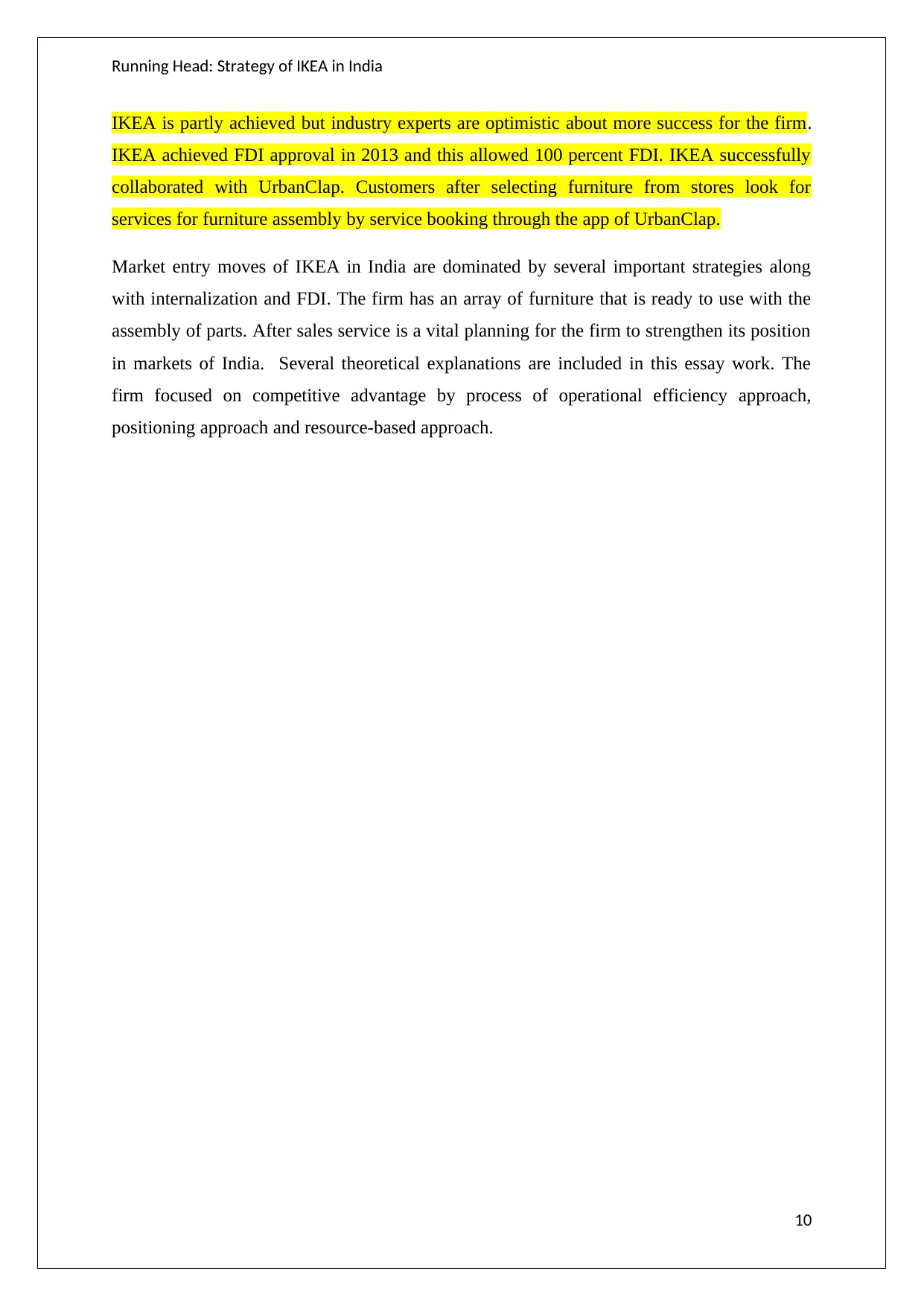
Running Head: Strategy of IKEA in India
IKEA is partly achieved but industry experts are optimistic about more success for the firm.
IKEA achieved FDI approval in 2013 and this allowed 100 percent FDI. IKEA successfully
collaborated with UrbanClap. Customers after selecting furniture from stores look for
services for furniture assembly by service booking through the app of UrbanClap.
Market entry moves of IKEA in India are dominated by several important strategies along
with internalization and FDI. The firm has an array of furniture that is ready to use with the
assembly of parts. After sales service is a vital planning for the firm to strengthen its position
in markets of India. Several theoretical explanations are included in this essay work. The
firm focused on competitive advantage by process of operational efficiency approach,
positioning approach and resource-based approach.
10
IKEA is partly achieved but industry experts are optimistic about more success for the firm.
IKEA achieved FDI approval in 2013 and this allowed 100 percent FDI. IKEA successfully
collaborated with UrbanClap. Customers after selecting furniture from stores look for
services for furniture assembly by service booking through the app of UrbanClap.
Market entry moves of IKEA in India are dominated by several important strategies along
with internalization and FDI. The firm has an array of furniture that is ready to use with the
assembly of parts. After sales service is a vital planning for the firm to strengthen its position
in markets of India. Several theoretical explanations are included in this essay work. The
firm focused on competitive advantage by process of operational efficiency approach,
positioning approach and resource-based approach.
10
Paraphrase This Document
Need a fresh take? Get an instant paraphrase of this document with our AI Paraphraser
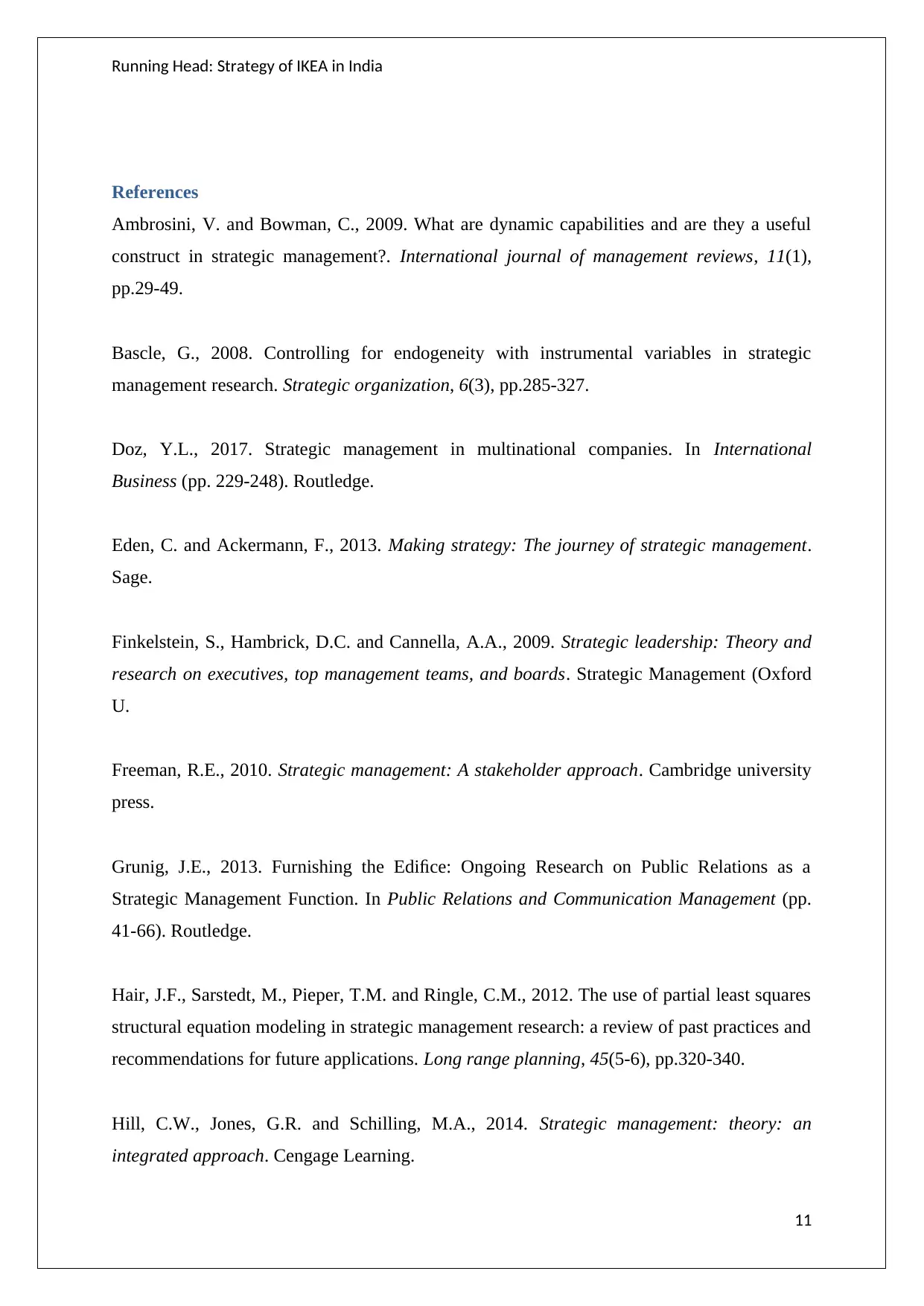
Running Head: Strategy of IKEA in India
References
Ambrosini, V. and Bowman, C., 2009. What are dynamic capabilities and are they a useful
construct in strategic management?. International journal of management reviews, 11(1),
pp.29-49.
Bascle, G., 2008. Controlling for endogeneity with instrumental variables in strategic
management research. Strategic organization, 6(3), pp.285-327.
Doz, Y.L., 2017. Strategic management in multinational companies. In International
Business (pp. 229-248). Routledge.
Eden, C. and Ackermann, F., 2013. Making strategy: The journey of strategic management.
Sage.
Finkelstein, S., Hambrick, D.C. and Cannella, A.A., 2009. Strategic leadership: Theory and
research on executives, top management teams, and boards. Strategic Management (Oxford
U.
Freeman, R.E., 2010. Strategic management: A stakeholder approach. Cambridge university
press.
Grunig, J.E., 2013. Furnishing the Edifice: Ongoing Research on Public Relations as a
Strategic Management Function. In Public Relations and Communication Management (pp.
41-66). Routledge.
Hair, J.F., Sarstedt, M., Pieper, T.M. and Ringle, C.M., 2012. The use of partial least squares
structural equation modeling in strategic management research: a review of past practices and
recommendations for future applications. Long range planning, 45(5-6), pp.320-340.
Hill, C.W., Jones, G.R. and Schilling, M.A., 2014. Strategic management: theory: an
integrated approach. Cengage Learning.
11
References
Ambrosini, V. and Bowman, C., 2009. What are dynamic capabilities and are they a useful
construct in strategic management?. International journal of management reviews, 11(1),
pp.29-49.
Bascle, G., 2008. Controlling for endogeneity with instrumental variables in strategic
management research. Strategic organization, 6(3), pp.285-327.
Doz, Y.L., 2017. Strategic management in multinational companies. In International
Business (pp. 229-248). Routledge.
Eden, C. and Ackermann, F., 2013. Making strategy: The journey of strategic management.
Sage.
Finkelstein, S., Hambrick, D.C. and Cannella, A.A., 2009. Strategic leadership: Theory and
research on executives, top management teams, and boards. Strategic Management (Oxford
U.
Freeman, R.E., 2010. Strategic management: A stakeholder approach. Cambridge university
press.
Grunig, J.E., 2013. Furnishing the Edifice: Ongoing Research on Public Relations as a
Strategic Management Function. In Public Relations and Communication Management (pp.
41-66). Routledge.
Hair, J.F., Sarstedt, M., Pieper, T.M. and Ringle, C.M., 2012. The use of partial least squares
structural equation modeling in strategic management research: a review of past practices and
recommendations for future applications. Long range planning, 45(5-6), pp.320-340.
Hill, C.W., Jones, G.R. and Schilling, M.A., 2014. Strategic management: theory: an
integrated approach. Cengage Learning.
11
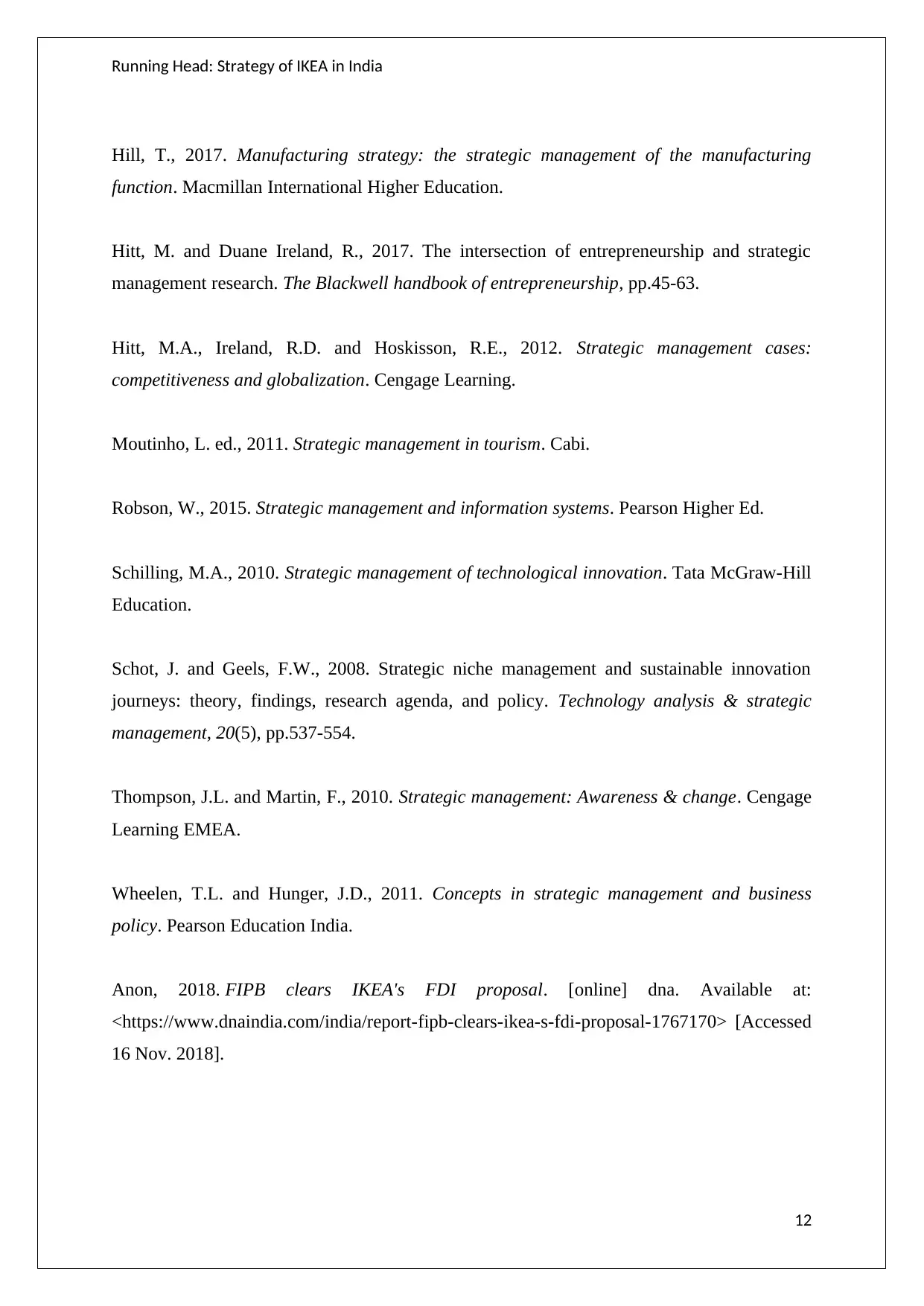
Running Head: Strategy of IKEA in India
Hill, T., 2017. Manufacturing strategy: the strategic management of the manufacturing
function. Macmillan International Higher Education.
Hitt, M. and Duane Ireland, R., 2017. The intersection of entrepreneurship and strategic
management research. The Blackwell handbook of entrepreneurship, pp.45-63.
Hitt, M.A., Ireland, R.D. and Hoskisson, R.E., 2012. Strategic management cases:
competitiveness and globalization. Cengage Learning.
Moutinho, L. ed., 2011. Strategic management in tourism. Cabi.
Robson, W., 2015. Strategic management and information systems. Pearson Higher Ed.
Schilling, M.A., 2010. Strategic management of technological innovation. Tata McGraw-Hill
Education.
Schot, J. and Geels, F.W., 2008. Strategic niche management and sustainable innovation
journeys: theory, findings, research agenda, and policy. Technology analysis & strategic
management, 20(5), pp.537-554.
Thompson, J.L. and Martin, F., 2010. Strategic management: Awareness & change. Cengage
Learning EMEA.
Wheelen, T.L. and Hunger, J.D., 2011. Concepts in strategic management and business
policy. Pearson Education India.
Anon, 2018. FIPB clears IKEA's FDI proposal. [online] dna. Available at:
<https://www.dnaindia.com/india/report-fipb-clears-ikea-s-fdi-proposal-1767170> [Accessed
16 Nov. 2018].
12
Hill, T., 2017. Manufacturing strategy: the strategic management of the manufacturing
function. Macmillan International Higher Education.
Hitt, M. and Duane Ireland, R., 2017. The intersection of entrepreneurship and strategic
management research. The Blackwell handbook of entrepreneurship, pp.45-63.
Hitt, M.A., Ireland, R.D. and Hoskisson, R.E., 2012. Strategic management cases:
competitiveness and globalization. Cengage Learning.
Moutinho, L. ed., 2011. Strategic management in tourism. Cabi.
Robson, W., 2015. Strategic management and information systems. Pearson Higher Ed.
Schilling, M.A., 2010. Strategic management of technological innovation. Tata McGraw-Hill
Education.
Schot, J. and Geels, F.W., 2008. Strategic niche management and sustainable innovation
journeys: theory, findings, research agenda, and policy. Technology analysis & strategic
management, 20(5), pp.537-554.
Thompson, J.L. and Martin, F., 2010. Strategic management: Awareness & change. Cengage
Learning EMEA.
Wheelen, T.L. and Hunger, J.D., 2011. Concepts in strategic management and business
policy. Pearson Education India.
Anon, 2018. FIPB clears IKEA's FDI proposal. [online] dna. Available at:
<https://www.dnaindia.com/india/report-fipb-clears-ikea-s-fdi-proposal-1767170> [Accessed
16 Nov. 2018].
12
⊘ This is a preview!⊘
Do you want full access?
Subscribe today to unlock all pages.

Trusted by 1+ million students worldwide
1 out of 12
Related Documents
Your All-in-One AI-Powered Toolkit for Academic Success.
+13062052269
info@desklib.com
Available 24*7 on WhatsApp / Email
![[object Object]](/_next/static/media/star-bottom.7253800d.svg)
Unlock your academic potential
Copyright © 2020–2025 A2Z Services. All Rights Reserved. Developed and managed by ZUCOL.




